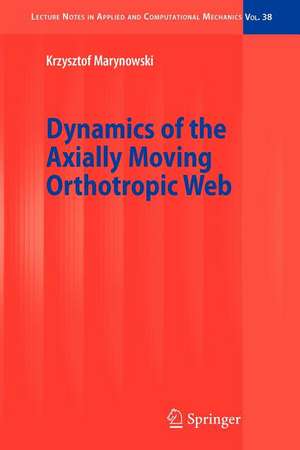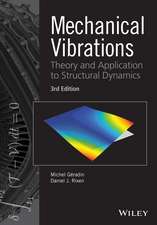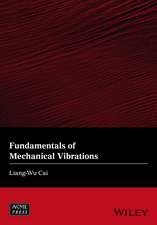Dynamics of the Axially Moving Orthotropic Web: Lecture Notes in Applied and Computational Mechanics, cartea 38
Autor Krzysztof Marynowskien Limba Engleză Paperback – 9 oct 2011
The book is devoted to dynamics of axially moving material objects of low flexural stiffness that are referred to as webs. Webs are moving at high speed, for example, in paper production the paper webs are transported with longitudinal speeds of up to 3000 m/min. Above the critical speed one can expect various dynamical instabilities mainly of divergent and flutter type.
The up-to-date state of investigations conducted in the field of the axially moving system dynamics is presented in the beginning of the book. Special attention is paid on nonlinear dynamic investigations of translating systems. In the next chapters various mathematical models that can be employed in dynamic investigations of such objects and the results of analysis of the dynamic behavior of the axially moving orthotropic material web are presented. To make tracing the dynamic considerations easier, a paper web is the main object of investigations in the book.
| Toate formatele și edițiile | Preț | Express |
|---|---|---|
| Paperback (1) | 634.00 lei 6-8 săpt. | |
| Springer Berlin, Heidelberg – 9 oct 2011 | 634.00 lei 6-8 săpt. | |
| Hardback (1) | 640.06 lei 6-8 săpt. | |
| Springer Berlin, Heidelberg – 26 sep 2008 | 640.06 lei 6-8 săpt. |
Din seria Lecture Notes in Applied and Computational Mechanics
- 19%
 Preț: 422.94 lei
Preț: 422.94 lei - 18%
 Preț: 1008.12 lei
Preț: 1008.12 lei - 18%
 Preț: 1120.18 lei
Preț: 1120.18 lei - 20%
 Preț: 560.79 lei
Preț: 560.79 lei - 18%
 Preț: 948.16 lei
Preț: 948.16 lei - 24%
 Preț: 1567.82 lei
Preț: 1567.82 lei - 15%
 Preț: 643.65 lei
Preț: 643.65 lei - 18%
 Preț: 956.81 lei
Preț: 956.81 lei - 18%
 Preț: 957.62 lei
Preț: 957.62 lei - 15%
 Preț: 649.87 lei
Preț: 649.87 lei - 18%
 Preț: 1224.54 lei
Preț: 1224.54 lei - 18%
 Preț: 956.50 lei
Preț: 956.50 lei - 18%
 Preț: 954.45 lei
Preț: 954.45 lei - 18%
 Preț: 948.92 lei
Preț: 948.92 lei - 18%
 Preț: 949.55 lei
Preț: 949.55 lei - 15%
 Preț: 644.49 lei
Preț: 644.49 lei - 18%
 Preț: 1234.62 lei
Preț: 1234.62 lei - 18%
 Preț: 777.69 lei
Preț: 777.69 lei - 18%
 Preț: 1221.83 lei
Preț: 1221.83 lei - 15%
 Preț: 643.00 lei
Preț: 643.00 lei - 18%
 Preț: 956.33 lei
Preț: 956.33 lei - 15%
 Preț: 640.88 lei
Preț: 640.88 lei - 15%
 Preț: 645.79 lei
Preț: 645.79 lei - 18%
 Preț: 944.99 lei
Preț: 944.99 lei - 18%
 Preț: 956.18 lei
Preț: 956.18 lei - 18%
 Preț: 1236.69 lei
Preț: 1236.69 lei - 18%
 Preț: 953.97 lei
Preț: 953.97 lei - 15%
 Preț: 640.88 lei
Preț: 640.88 lei
Preț: 634.00 lei
Preț vechi: 745.88 lei
-15% Nou
Puncte Express: 951
Preț estimativ în valută:
121.31€ • 127.34$ • 100.69£
121.31€ • 127.34$ • 100.69£
Carte tipărită la comandă
Livrare economică 10-24 aprilie
Preluare comenzi: 021 569.72.76
Specificații
ISBN-13: 9783642097805
ISBN-10: 3642097804
Pagini: 164
Ilustrații: VIII, 154 p. 127 illus.
Dimensiuni: 155 x 235 x 9 mm
Greutate: 0.24 kg
Ediția:2008
Editura: Springer Berlin, Heidelberg
Colecția Springer
Seria Lecture Notes in Applied and Computational Mechanics
Locul publicării:Berlin, Heidelberg, Germany
ISBN-10: 3642097804
Pagini: 164
Ilustrații: VIII, 154 p. 127 illus.
Dimensiuni: 155 x 235 x 9 mm
Greutate: 0.24 kg
Ediția:2008
Editura: Springer Berlin, Heidelberg
Colecția Springer
Seria Lecture Notes in Applied and Computational Mechanics
Locul publicării:Berlin, Heidelberg, Germany
Public țintă
ResearchCuprins
State of Knowledge on Dynamics of Axially Moving Systems.- Dynamical Analysis of the Undamped Axially Moving Web System.- Displacements of the Web in Equilibrium States of the Linearized System.- Dynamics of the Axially Moving Viscoelastic Web.- Beam Model of the Moving Viscoelastic Web.- Concluding Remarks.
Recenzii
From the reviews:
"This book is devoted to dynamics of axially moving material objects of low flexural stifness that are referred to as webs. … The material presented in the book is very useful for practicing engineers and research workers. The reviewer enjoyed reading the book and recommends it strongly to all those who are actively engaged in research in the area of applied mechanics and computational mechanics." (Girish Ramaiah, Zentralblatt MATH, Vol. 1152, 2009)
"This book is devoted to dynamics of axially moving material objects of low flexural stifness that are referred to as webs. … The material presented in the book is very useful for practicing engineers and research workers. The reviewer enjoyed reading the book and recommends it strongly to all those who are actively engaged in research in the area of applied mechanics and computational mechanics." (Girish Ramaiah, Zentralblatt MATH, Vol. 1152, 2009)
Textul de pe ultima copertă
The book is concentrated with an analysis of the dynamic behaviour of axially moving orthotropic web. Axially moving materials are of technological importance and are present in various industrial applications. Power transmission belts, paper and plastic sheets in process, the steel strip in a thin steel sheet production line, the band saw blade are only some examples of two-dimensional continua, where vibrations are associated with an axial transport of mass. Generally, axially moving continuum in the form of thin, flat rectangular shape material with small flexural stiffness is called a web. Webs are moving at high speed, for example, in paper production the paper webs are transported with longitudinal speeds of up to 3000 m/min. Above the critical speed one can expect various dynamical instabilities mainly of divergent and flutter type. These instabilities can decrease the quality of products and their performance. The instability of band saw results in low surface quality, unsatisfactory cutting performance and leads to the loss of raw materials. In paper production, the machines instabilities, resonance oscillations and the flutter of the web can cause the wrinkling or even a breaking of the web. On the other hand one important problem in these systems is the occurrence of large transverse vibrations due to tension variations termed as parametric vibrations. Dynamic response and stability associated with parametric vibrations are of primary concern in the dynamic investigations of these systems. To ensure that the operating system is under stable working conditions, full analysis of its dynamics has to be performed. Complete knowledge of the dynamical behaviour allows the prediction and control of instabilities.
In the beginning part of this book the up-to-date state of knowledge in the field of dynamic behaviour of axially moving materials is presented. The first studies on this subject date in the middle of the twentieth century. Historically, theone-dimensional string theory, the beam theory, and the two-dimensional plate theory were successively used in modelling the axially moving continua. To avoid complications, a lot of earlier works for modelling of two-dimensional axially moving materials used the one-dimensional string or beam theory instead of the plate theory. Although this simplification leads to reasonable results in particular cases, the two-dimensional analysis is required for modelling of many problems such as composite materials, wide width plates, various forces across the width and etc. In the reference review the works from the last twenty years are mostly taken into account. The particular emphasis is paid on the role of nonlinearities in the dynamic behaviour of the travelling systems.
In the next part of the book a nonlinear mathematical model of the axially moving orthotropic web is derived. The non-linear orthotropic plate theory is modified to include the internal forces resulting from the moving web and internal damping of travelling material. The differential equations of motion are derived from the Hamilton’s principle taking into account the Lagrange description, the strain Green tensor for thin-walled plates and the Kirchhoff stress tensor. The mathematical model has the form of two non-linear partial differential equations which describe transverse motion of the web and the field of sectional forces
In the next part of the book the solutions of the mathematical model that show displacements and critical transport speeds of the web in equilibrium states of the linearized system are presented. Static analysis, by determination of the non-trivial equilibrium positions existence is used in investigations of stability of the web motion. Equations of equilibrium positions of axially moving web with uniform motion are derived. Transverse displacements and wrinkling of the webs of two kinds of papers and the corrugated board constructed with these papers arenumerically investigated.
The investigation results of stability of the non-linear system motion are presented in the final part of the book. The Galerkin method is used to discretize the governing equations of motions and a high dimensional system of ordinary differential equations is obtained. The dynamic behaviour is studied in the sub- and super-critical speed ranges of the web. Three different rheological model of internal damping are taken into consideration in the dynamic studies of the beam model of the traveling web.
Important features of the book
In the beginning part of this book the up-to-date state of knowledge in the field of dynamic behaviour of axially moving materials is presented. The first studies on this subject date in the middle of the twentieth century. Historically, theone-dimensional string theory, the beam theory, and the two-dimensional plate theory were successively used in modelling the axially moving continua. To avoid complications, a lot of earlier works for modelling of two-dimensional axially moving materials used the one-dimensional string or beam theory instead of the plate theory. Although this simplification leads to reasonable results in particular cases, the two-dimensional analysis is required for modelling of many problems such as composite materials, wide width plates, various forces across the width and etc. In the reference review the works from the last twenty years are mostly taken into account. The particular emphasis is paid on the role of nonlinearities in the dynamic behaviour of the travelling systems.
In the next part of the book a nonlinear mathematical model of the axially moving orthotropic web is derived. The non-linear orthotropic plate theory is modified to include the internal forces resulting from the moving web and internal damping of travelling material. The differential equations of motion are derived from the Hamilton’s principle taking into account the Lagrange description, the strain Green tensor for thin-walled plates and the Kirchhoff stress tensor. The mathematical model has the form of two non-linear partial differential equations which describe transverse motion of the web and the field of sectional forces
In the next part of the book the solutions of the mathematical model that show displacements and critical transport speeds of the web in equilibrium states of the linearized system are presented. Static analysis, by determination of the non-trivial equilibrium positions existence is used in investigations of stability of the web motion. Equations of equilibrium positions of axially moving web with uniform motion are derived. Transverse displacements and wrinkling of the webs of two kinds of papers and the corrugated board constructed with these papers arenumerically investigated.
The investigation results of stability of the non-linear system motion are presented in the final part of the book. The Galerkin method is used to discretize the governing equations of motions and a high dimensional system of ordinary differential equations is obtained. The dynamic behaviour is studied in the sub- and super-critical speed ranges of the web. Three different rheological model of internal damping are taken into consideration in the dynamic studies of the beam model of the traveling web.
Important features of the book
- The up-to-date knowledge in the field of dynamic behaviour of axially moving two-dimensional materials is gathered and arranged in the one place. To the author’s opinion this is the first attempt to arrange this knowledge in the book-form.
- The results of the investigations to be discussed in this book are concerned mainly paper webs used in manufacturing of corrugated board. The parameters of the considered papers are determined in experimental way. The corrugated board web, composed of these papers and treated as a composite structure, is an object of the investigations as well.
- The effects of the geometric nonlinearity, the internal damping of the moving materials, and the tension perturbations treated as parametric excitation on the dynamic behaviour of the system are numerically investigated.
Caracteristici
Presents the state of knowledge in the field of dynamic behaviour of axially moving materials












